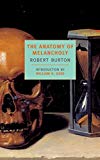
Burton defined his subject as follows:
Melancholy , the subject of our present discourse, is either in disposition or in habit. In disposition, is that transitory Melancholy which goes and comes upon every small occasion of sorrow, need, sickness, trouble, fear, grief, passion, or perturbation of the mind, any manner of care, discontent, or thought, which causes anguish, dulness, heaviness and vexation of spirit, any ways opposite to pleasure, mirth, joy, delight, causing forwardness in us, or a dislike. In which equivocal and improper sense, we call him melancholy, that is dull, sad, sour, lumpish, ill-disposed, solitary, any way moved, or displeased. And from these melancholy dispositions no man living is free, no Stoick, none so wise, none so happy, none so patient, so generous, so godly, so divine, that can vindicate himself; so well-composed, but more or less, some time or other, he feels the smart of it. Melancholy in this sense is the character of Mortality... This Melancholy of which we are to treat, is a habit, a serious ailment, a settled humour, as Aurelianus and others call it, not errant, but fixed: and as it was long increasing, so, now being (pleasant or painful) grown to a habit, it will hardly be removed.
In attacking his stated subject, Burton drew from nearly every science of his day, including psychology and physiology, but also astronomy, meteorology, and theology, and even astrology and demonology.
Much of the book consists of quotations from various ancient and medieval medical authorities, beginning with Hippocrates, Aristotle, and Galen. Hence the Anatomy is filled with more or less pertinent references to the works of others. A competent Latinist, Burton also included a great deal of Latin poetry in the Anatomy , and many of his inclusions from ancient sources are left untranslated in the text.
The Anatomy of Melancholy is an especially lengthy book, the first edition being a single quarto volume nearly 900 pages long; subsequent editions were even longer. The text is divided into three major sections plus an introduction, the whole written in Burton's sprawling style. Characteristically, the introduction includes not only an author's note (titled "Democritus Junior to the Reader"), but also a Latin poem ("Democritus Junior to His Book"), a warning to "The Reader Who Employs His Leisure Ill", an abstract of the following text, and another poem explaining the frontispiece.
The following three sections proceed in a similarly exhaustive fashion: the first section focuses on the causes and symptoms of "common" melancholies, while the second section deals with cures for melancholy, and the third section explores more complex and esoteric melancholies, including the melancholy of lovers and all varieties of religious melancholies. The Anatomy concludes with an extensive index (which, many years later, The New York Times Book Review called "a readerly pleasure in itself" ). Most modern editions include many explanatory notes, and translate most of the Latin.
Already have an account? Log In Now